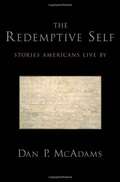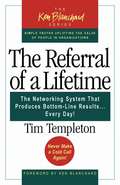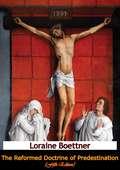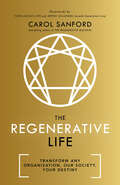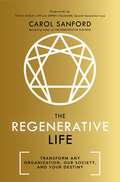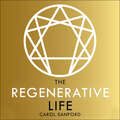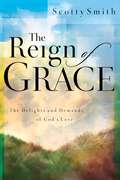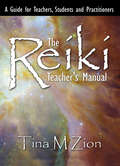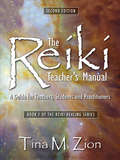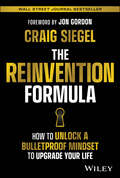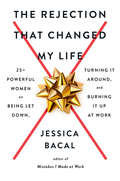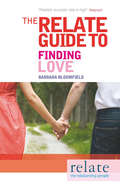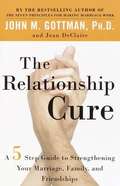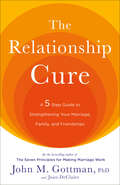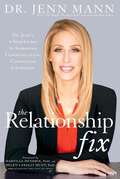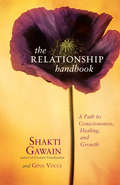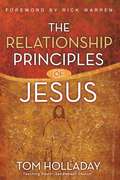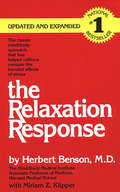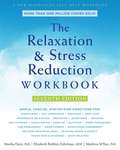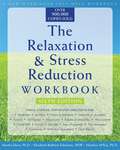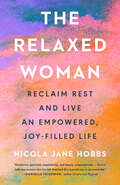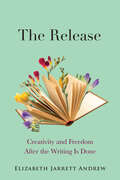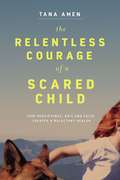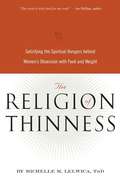- Table View
- List View
The Redemptive Self: Stories Americans Live By
by Dan P. McAdamsWho are we as Americans? What is our deep identity? How do we make a good life? Renowned psychologist Dan P. McAdams suggests that the key to American identity lies in the stories we live by. And the most powerful life story in America today is the story of redemption. On a broad societal scale and in our own private lives, we want first and foremost to transform our suffering into a positive emotional state, to move from pain and peril to redemption. American identity is the redemptive self. Based on 10 years of research on the life stories of especially caring and productive American adults, The Redemptive Self explores the psychological and cultural dynamics of the stories Americans tell to make sense of who they are. Among the most eloquent tellers of redemptive stories are those midlife adults who are especially committed to their careers, their families, and making a positive difference in the world. These highly "generative" men and women embrace the negative things that happen to them, for it is by transforming the bad into good that they are able to move forward in life and ultimately leave something positive behind. Unconsciously, they find inspiration and sustenance in the rich store of redemptive tales that American culture offers - from the autobiographies of Massachusetts Puritans, Benjamin Franklin, and escaped African-American slaves to the stories of upward mobility, recovery, fulfillment, and release that come to us today from Hollywood, 12-step programs, self-help experts, religious stories, political speeches, business gurus, and Oprah. But can all American lives find redemption? Some people seem unable to make their lives into redemptive tales. Instead, their stories show contaminated plots and vicious cycles. Moreover, might there be a dark side to the redemptive stories Americans love? While these stories can sustain a productive and caring approach to life, they can also suggest a peculiarly American kind of arrogance and self-righteousness. For all their strengths, redemptive stories sometimes fail, and sometimes suggest important failings in the way Americans see themselves and the world. The Redemptive Self encourages us to examine our lives and our stories in full, to apprehend both the good and the bad in the stories we live by. By doing so, we may fashion better stories and better lives for the future.
The Referral of a Lifetime: The Networking System That Produces Bottom-Line Results... Every Day!
by Timothy L. Templeton Lynda Rutledge StephensonIn "The Referral of a Lifetime", author Tim Templeton frames a powerful plan for cultivating clients and customers in a fable about businesswoman Susie McCumber, who feels increasingly like a failure. A friend refers her to the mysterious Mr. Highground, who introduces her to four successful people. They show her how they transformed their businesses and their lives by determining how others view them and how they view themselves as both human beings and businesspeople. Each of the four represents a "type" in this schema -- from the "relational/business" type who puts the relationship first but thinks strategically when the talk turns to business, to the "business/business" type, who avoids relationships unless they work to a business advantage. Templeton shows how understanding one's type allows one to showcase strengths while improving weak areas in this simple, easy-to-use guide to success in business and in life.
The Reformed Doctrine of Predestination [Fifth Edition]
by Loraine BoettnerFirst published in 1941, this is the Fifth Edition of Loraine Boettner’s 1932 publication The Reformed Doctrine of Predestination and is widely considered to be one of the 20th-century’s most reasoned explanations of the sovereignty of God and the Reformed interpretation of salvation.“THE purpose of this book is not to set forth a new system of theological thought, but to give a restatement to that great system which is known as the Reformed Faith or Calvinism, and to show that this is beyond all doubt the teaching of the Bible and of reason.”—Loraine Boettner, Introduction“Whoever really wants to know what Calvinism teaches cannot do better than to read this book from cover to cover”.—United Presbyterian magazine
The Regenerative Life: Transform Any Organization, Our Society, and Your Destiny
by Carol SanfordThe world often falls short of how we'd like it to be, and our ability to make even just a little difference can seem limited. Sometimes it feels like you need to be a super-hero to achieve anything meaningful. But what if by re-conceiving what you do, you could change the world for the better?In THE REGENERATIVE LIFE, Carol Sanford shows you how to fundamentally change the roles you play in society, enabling you to do more than you ever believed possible; grow yourself and others, provide astounding innovations for your clients, children and students, generate extraordinary social returns, become more creative, and bring new life and opportunity to everything around you. THE REGENERATIVE LIFE teaches you to see your roles differently: stripping away all preconceptions of how it should be done, understanding what your role is at its core, and building yourself back up to become something new; something so grounded, inspiring, and resilient, it can change the world.
The Regenerative Life: Transform any organization, our society, and your destiny
by Carol SanfordThe world often falls short of how we'd like it to be, and our ability to make even just a little difference can seem limited. Sometimes it feels like you need to be a super-hero to achieve anything meaningful. But what if by re-conceiving what you do, you could change the world for the better?In THE REGENERATIVE LIFE, Carol Sanford shows you how to fundamentally change the roles you play in society, enabling you to do more than you ever believed possible; grow yourself and others, provide astounding innovations for your clients, children and students, generate extraordinary social returns, become more creative, and bring new life and opportunity to everything around you. THE REGENERATIVE LIFE teaches you to see your roles differently: stripping away all preconceptions of how it should be done, understanding what your role is at its core, and building yourself back up to become something new; something so grounded, inspiring, and resilient, it can change the world.
The Regenerative Life: Transform any organization, our society, and your destiny
by Carol SanfordAward-winning author, expert speaker and executive coach, Carol Sanford, borrows the concept of regeneration from biology and uniquely applies it personal growth to reveal a new way to produce and inspire change in the world.The world often falls short of how we'd like it to be, and our ability to make even just a little difference can seem limited. Sometimes it feels like you need to be a super-hero to achieve anything meaningful. But what if by re-conceiving what you do, you could change the world for the better?In THE REGENERATIVE LIFE, Carol Sanford shows you how to fundamentally change the roles you play in society, enabling you to do more than you ever believed possible; grow yourself and others, provide astounding innovations for your clients, children and students, generate extraordinary social returns, become more creative, and bring new life and opportunity to everything around you. THE REGENERATIVE LIFE teaches you to see your roles differently: stripping away all preconceptions of how it should be done, understanding what your role is at its core, and building yourself back up to become something new; something so grounded, inspiring, and resilient, it can change the world.(P) 2022 Hodder & Stoughton Limited
The Reign of Grace: The Delignts and Demands of God's Love
by Scotty SmithPastor Scotty Smith challenges readers humbly and honestly to consider what it means to be stewards of God's grace—to live a life of obedience and service in response to His wonderful love.With breakthrough understanding, this book reconciles the disconnection between God's faithfulness to Christians and their unfaithfulness to Him.
The Reiki Teacher's Manual: A Guide for Teachers, Students, and Practitioners (The Reiki Healing Series #1)
by Tina M. ZionThis book is designed for students, practitioners, and teachers. It will enrich the classes that current teachers are giving and gives the new teacher confidence and pride when providing that very first class. Practitioners will have a greater understanding of how to apply Reiki and what is actually happening during a session. You will never again be afraid or even worried about teaching a Reiki class or giving the attunement. You will be pleased and your students will be grateful for the rich content in your classes. "The Reiki Teacher's Manual" is a precise step-by-step guide to instruct all three levels or degrees of Reiki. This manual and its format provide you with: A concise manual that is user friendly; A quick reference to answer student's questions; Consecutive steps with time approximations to make sure you teach all the information and still have plenty of time for the hands on practice sessions. How to get the most for your students during their hands on practice; How to increase the power of your attunement; How to teach the attunement to others; Goals for different segments of each class; Detailed descriptions and uses for the symbols; 15 handouts that are concise, informative, and can be copied from the book; Complete written explanations for each handout; A list of supplies for each level and suggestions for your classroom environment; Guidelines in opening your own Reiki practice; Information regarding state licensing needs; How to avoid issues with physicians and the medical community.
The Reiki Teacher’s Manual: A Guide For Teachers, Students, And Practitioners (The\reiki Healing Ser. #1)
by Tina M. ZionThe Reinvention Formula: How to Unlock a Bulletproof Mindset to Upgrade Your Life
by Craig SiegelReinvention is ready when you areIn The Reinvention Formula: How to Unlock a Bulletproof Mindset to Upgrade Your Life, accomplished speaker and performance coach Craig Siegel walks you through the exciting process of fundamentally redefining your identity and how you choose to show up in the world. In the book, you’ll find a new level of clarity, feel more worthy, learn to grow from failure and pivot successfully, find what sets your soul on fire, and commit to changing the course of your life and finding the fulfilment you’ve been missing. The author explores lasting lessons, stories, and strategies drawn from his popular The CLS Experience podcast where he has interviewed countless celebrities, athletes, thought leaders, and bestselling authors. The material within is raw, real, and relatable to anyone, from any background, and in any industry. You’ll also find: Strategies for eliminating negative, unproductive thoughts and replacing them with constructive new beliefs that drive incredible results in your personal and professional lives Ways to balance making an impact, earning a lucrative living, and cultivating a new mindset Methods for reimagining how you present yourself to other people The Reinvention Formula is a step-by-step walkthrough for anyone ready to put in the effort to completely reimagine how they relate to the world around them.
The Rejection That Changed My Life: 25+ Powerful Women on Being Let Down, Turning It Around, and Burning It Up at Work
by Jessica BacalFrom the groundbreaking author of Mistakes I Made at Work, comes the perfect book for anyone who needs inspiration after dealing with rejection, failure, or is searching for a new beginning in the workplace. Featuring fascinating interviews with more than twenty-five women, including Keri Smith, Angela Duckworth, and Roz Chast, The Rejection That Changed My Life provides an exciting new way to think about career challenges, changes, and triumphs. Rejections don't go on your résumé, but they are part of every successful person's career. All of us will apply for jobs that we don't get and have ambitions that aren't fulfilled, because that is part of being a working person, part of pushing oneself to the next step professionally. While everyone deserves feel-better stories, women are more likely to ruminate, more likely to overthink rejection until it becomes even more painful—a situation that the women in this collection are determined to change, and in so doing, normalize rejection and encourage others to talk about it. Empowering and full of heart, the stories in this collection are diverse in every sense, by top women from many cultural backgrounds and in a wide variety of fields; many of their hard-earned lessons are universal. There are stories from engineers, entrepreneurs, activists, comedians, professors, lawyers, chefs, and more on how they coped with rejection and even experienced it as a catalyst for their own personal professional growth. Powerful, motivating, and endlessly quotable and shareable, The Rejection That Changed My Life will become the go-to book for women at any stage of their career learning to navigate the workforce.
The Relate Guide to Finding Love
by Barbara Bloomfield RelateWhy are you looking for love right now? What kind of relationship do you want? How will you know if you find 'The One'? The Relate Guide to Finding Love will answer all these questions, and more.From the UK's leading relationship counsellor, The Relate Guide to Finding Love offers common sense help and advice on all aspects of dating and relationships. Short, snappy chapters, each containing a thought-provoking exercise, plus personal case histories, combine to make this a fun and interesting read to help you to:- Discover your needs and what you expect from a relationship- Get yourself into the right frame of mind to meet someone new- Make the most of online dating and singles events- Identify whether your new love is really the one for youWhether you are looking for a long-term relationship or just a quick fling, this practical, accessible guide is perfect for you.
The Relationship Cure: A 5 Step Guide to Strengthening Your Marriage, Family, and Friendships
by John Gottman Joan DeclaireA groundbreaking, practical program for transforming troubled relationships into positive ones "This is the best book on relationships I have ever read. . . . John Gottman has decoded the subtle secrets that can either enrich or destroy the quality of our ties with others. " Daniel B. Wile, Ph. D. , author ofAfter the Fight: Using Your Disagreements to Build a Stronger Relationship "John Gottman is our leading explorer of the inner world of relationships. InThe Relationship Cure, he has found gold once again. "William J. Doherty, Ph. D. , author ofTake Back Your Marriage: Sticking Together in a World That Pulls Us Apart "When he says his five steps will help you build better connections with the people you care about, you know that they have been demonstrated to work. " E. Mavis Heatherington, Ph. D. , professor of psychology, University of Virginia From the country's foremost relationship expert andNew York Timesbestselling author Dr. John M. Gottman comes a powerful, simple five-step program, based on twenty years of innovative research, for greatly improving all of the relationships in your life--with spouses and lovers, children, siblings, and even your colleagues at work. In The Relationship Cure, Dr. Gottman: * Reveals the key elements of healthy relationships, emphasizing the importance of what he calls "emotional connection" * Introduces the powerful new concept of the emotional "bid," the fundamental unit of emotional connection * Provides remarkably empowering tools for improving the way you bid for emotional connection and how you respond to others' bids
The Relationship Cure: A 5 Step Guide to Strengthening Your Marriage, Family, and Friendships
by John GottmanA groundbreaking, practical program for transforming troubled relationships into positive ones“This is the best book on relationships I have ever read. . . . John Gottman has decoded the subtle secrets that can either enrich or destroy the quality of our ties with others.” Daniel B. Wile, Ph.D., author of After the Fight: Using Your Disagreements to Build a Stronger Relationship“John Gottman is our leading explorer of the inner world of relationships. In The Relationship Cure, he has found gold once again.”William J. Doherty, Ph.D., author of Take Back Your Marriage: Sticking Together in a World That Pulls Us Apart“When he says his five steps will help you build better connections with the people you care about, you know that they have been demonstrated to work.” E. Mavis Heatherington, Ph.D., professor of psychology, University of VirginiaFrom the country’s foremost relationship expert and New York Times bestselling author Dr. John M. Gottman comes a powerful, simple five-step program, based on twenty years of innovative research, for greatly improving all of the relationships in your life—with spouses and lovers, children, siblings, and even your colleagues at work. In The Relationship Cure, Dr. Gottman:* Reveals the key elements of healthy relationships, emphasizing the importance of what he calls “emotional connection”* Introduces the powerful new concept of the emotional “bid,” the fundamental unit of emotional connection* Provides remarkably empowering tools for improving the way you bid for emotional connection and how you respond to others’ bids
The Relationship Fix: Dr. Jenn's 6-Step Guide to Improving Communication, Connection & Intimacy
by Jenn MannCan your relationship be saved? The star of the hit VH1 show Couples Therapy with Dr. Jenn looks at what can be fixed, what can&’t, and what can take your relationship to new heights. In The Relationship Fix, Dr. Jenn Mann, the host and psychotherapist from VH1 Couples Therapy with Dr. Jenn, helps couples master must-have skills for sustaining a healthy, long-lasting relationship. Supported by the most up-to-date research, Dr. Jenn shares real-life stories from Couples Therapy cast members, clients in her private practice, and her own personal experiences. Dr. Jenn debunks common myths about what makes a relationship &“good&” or &“bad,&” and gives couples tools to communicate more effectively, work through conflicts, resolve issues that are damaging the relationship, and feel more connected. The last step in Dr. Jenn&’s six-step guide gives couples tried-and-true advice about improving their sex life—the perfect finale to a book that helps couples fix their relationships and ultimately take them to a new level.
The Relationship Handbook
by Shakti Gawain Gina VucciIn her first new book in 15 years, personal development pioneer Shakti Gawain encapsulates a lifetime of teaching and learning to offer her most trenchant and universal work to date. These exercises and insights have been tested and refined in the popular workshops Gawain has taught for decades. They reflect the fact that each of us is in relationships - with romantic partners, family, coworkers, etc. - and that each of us is also in relationships with internal core beliefs and a variety of selves, including primary, disowned, and shadow selves. Her revelatory teaching incorporates strategies for becoming aware of hidden beliefs, applying the Voice Dialogue process developed by therapists Hal and Sidra Stone, and learning to experience our every relationship as a path to self-knowledge, intrapersonal enhancement, and even community and global betterment.
The Relationship Principles of Jesus: How to Love Like Jesus
by Tom HolladayWhat would you give to radically improve, even transform, what matters most in your relationships? You can thrive in your career, acquire wealth, or build a great reputation. But if your relationships aren't thriving, nothing else matters.This 40-day journey will bring new depth and health to your marriage, your family, and your friendships. Saddleback Church teaching pastor Tom Holladay helps you explore and begin to practice six foundational principles including how to give your relationships the highest value, love as Jesus loves you, and communicate from the heart. You'll be equipped with insights and a practical path for fulfilling God&’s intention for all your relationships--even the difficult ones.The Relationship Principles of Jesus walks you step by step through learning the foundational relationship truths taught by Jesus. Shaped after Rick Warren's monumental bestseller, The Purpose Driven Life, this book invites you to learn from the Master of relationships.
The Relaxation Response
by Herbert BensonWhen Dr. Herbert Benson introduced this simple, effective, mind/body approach to relieving stress twenty-five years ago, his book became an instant national bestseller. Since that time, millions of people have learned the secret--without high-priced lectures or prescription medicines. The Relaxation Response has become the classic reference recommended by most health care professionals and authorities to treat the harmful effects of stress. Discovered by Dr. Benson and his colleagues in the laboratories of Harvard Medical School and its teaching hospitals, this revitalizing, therapeutic approach is now routinely recommended to treat patients suffering from heart conditions, high blood pressure, chronic pain, insomnia, and many other physical ailments. It requires only minutes to learn, and just ten to twenty minutes of practice twice a day.
The Relaxation Response
by Herbert Benson Miriam Z. KlipperWhen Dr. Herbert Benson introduced this simple, effective, mind/body approach to relieve stress in The Relaxation Response twenty-five years ago, the book became an instant national bestseller. Since that time, millions of people have learned the secret of the relaxation response--without high-priced lectures, drugs, or prescription medicine. The tremendous success of this approach has turned The Relaxation Response into the classic reference recommended by most health care professionals and authorities to treat the harmful effects of stress. This revitalizing, therapeutic approach, discovered by Dr. Benson and his colleagues in the laboratories of Harvard Medical School and its teaching hospitals, is now routinely recommended to treat patients suffering from heart conditions, high blood pressure, chronic pain, insomnia, and many other physical ailments. Requiring only minutes to learn, and just ten to twenty minutes of practice twice a day, the Relaxation Response has proven to be one of the most effective ways to relieve the tensions of modern-day living for a richer, healthier, more productive life.
The Relaxation and Stress Reduction Workbook
by Martha Davis Matthew McKay Elizabeth EshelmanThe Relaxation and Stress Reduction Workbook broke new ground when it was first published in 1980, detailing easy, step-by-step techniques for calming the body and mind in an increasingly overstimulated world. Now in its seventh edition, this fully revised and updated workbook—highly regarded by therapists and their clients—offers the latest stress reduction techniques to combat the effects of stress and integrate healthy relaxation habits into every aspect of daily life. <p><p> This new edition also includes powerful self-compassion practices, fully updated chapters on the most effective tools for coping with anxiety, fear, and panic—such as worry delay and defusion, two techniques grounded in acceptance and commitment therapy (ACT)—as well as a new section focused on body scan. <p> In the workbook, you’ll explore your own stress triggers and symptoms, and learn how to create a personal action plan for stress reduction. Each chapter features a different method for relaxation, explains why the method works, and provides on-the-spot exercises you can do when you feel stressed out. The result is a comprehensive yet accessible workbook that will help you to curb stress and cultivate a more peaceful life.
The Relaxation and Stress Reduction Workbook, 6th Edition
by Matthew Mckay Martha Davis Elizabeth Robbins EshelmanThis workbook teaches you clinically proven stress-management and relaxation techniques. Each technique is presented with concise background information followed by step-by-step exercises. As you practice these techniques, you will gain new insight into your personal stress response and learn how to reestablish balance and a sense of well-being in your life.
The Relaxed Woman: Reclaim Rest and Live an Empowered, Joy-Filled Life
by Nicola Jane HobbsHave you ever met a relaxed woman? Would you like to become one? Psychologist Nicola Jane Hobbs draws on the latest science and extensive therapeutic experience to dispel the myth that relaxing is lazy and show women how to reclaim rest as a path to healing, freedom, and joy.We have become a society of rushing women, overburdened women, exhausted women. Women whose lives are plagued with stress, guilt, and burnout. We try so hard to do it all—to be the perfect partners, mothers, daughters, colleagues, friends—only to end up feeling not good enough, unappreciated, and lonely. But it doesn&’t have to be this way.In The Relaxed Woman, psychologist Nicola Jane Hobbs explores how stress negatively impacts our minds, bodies and relationships, and illuminates a path towards reclaiming relaxation as a form of liberation. Weaving together neuroscience and psychology with inspirational stories from women who are discovering the transformational power of rest for themselves, Nicola guides us on a journey to becoming relaxed women: women who have untangled their sense of worth from their productivity, who can rest without guilt and anxiety, who trust their intuitions, honor their needs, and live by their deepest values.Filled with simple rest rituals we can weave into our busy lives, healing practices to help regulate our nervous systems, and practical strategies to support us in navigating the unavoidable stressors of life, The Relaxed Woman is an empowering, restful guide for all of us who long to live more joyful, authentic lives. Because we deserve more than being constantly exhausted. We deserve to be relaxed women, women who know our worth and our power—women who, together, can change the world.
The Release: Creativity and Freedom After the Writing Is Done
by Elizabeth Jarrett AndrewThe release is the stage when writers share the soul of their project—its gift. Here’s how to thrive and best serve your work once the writing is done.In The Release, award-winning author and teacher Elizabeth Jarrett Andrew invites writers to lift their heads out of the product-oriented sandbox and find an alternative way to play. By returning writers to their original delight and guiding them in an ongoing creative practice, Andrew helps form habits of mind, heart, and body to support a project’s final flourishing, free from the burdens of seeking validation and measuring worth.With the same skill and compassion she brought to her other resources for writers—Writing the Sacred Journey: The Art and Practice of Spiritual Memoir and Living Revision: A Writer's Craft as Spiritual Practice—Andrew writes with deep empathy for the emotional journey when a work is done, through celebration and grief, decisions around publication, the angst of receiving negative feedback or rejection, and the sometimes surprising challenges that come with success.Anyone—amateurs and professionals alike, those who intend to publish and those who do not, those with book-length manuscripts and those with haiku written on paper scraps—can do this practice. This book is for anyone who wants to release their work with love.
The Relentless Courage of a Scared Child: How Persistence, Grit, and Faith Created a Reluctant Healer
by Tana AmenA shocking and hopeful account of one woman's extraordinary courage to face her past and embrace truth in order to help others find hope and healingIn The Relentless Courage of a Scared Child, Tana Amen shares her incredible story of transformation—of growing up in poverty, a bullied latch-key kid raised on sugary cereal and junk food, to becoming a world-renowned food and fitness expert.Her challenging past of neglect, poverty, sexual abuse, thyroid cancer, and bouts of anxiety and depression set her on a path to find healing. Through her remarkable journey, we see more clearly the light that can shine through our own broken places and ultimately heal us: body, mind, and soul.At once tragic and heartwarming, Tana&’s story integrates cutting-edge psychology and proven wellness techniques from the Amen Clinics in a moving exploration of the healing available to each one of us, no matter the pain in our past.&“What a journey! With in-your-face honesty, Tana reveals how she was able to turn her pain into purpose. For anyone who has been faced with unspeakable loss, this message is so important.&” —Jay Shetty, #1 New York Times bestselling author of Think Like a Monk, storyteller, purpose coach, and former monk
The Religion of Thinness
by Michelle M. LelwicaWith so many women approaching their diets, body image, and pursuit of a slender figure with slavish devotion, The Religion of Thinness is a timely addition to the discussion of our cultural obsession with weight loss. At the heart of this obsession is the belief that in order to be happy, one must be slim, and the attendant myths, rituals, images, and moral codes can leave some women with severe emotional damage. Idealized images in the media inspire devotees of this "religion" to experience guilt for behaviors that are biologically normal and necessary, and Lelwica offers two ways to combat this dangerous cultural message. Advising readers to look hard at the societal cues that cause them to obsess about their weight, and to remain mindful about their actions and needs, this book will not only help stop the cycle of guilt and shame associated with food, it will help readers to grow and accept their bodies as they are.
